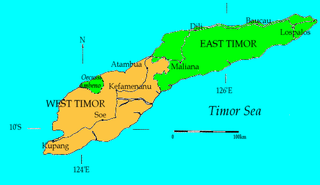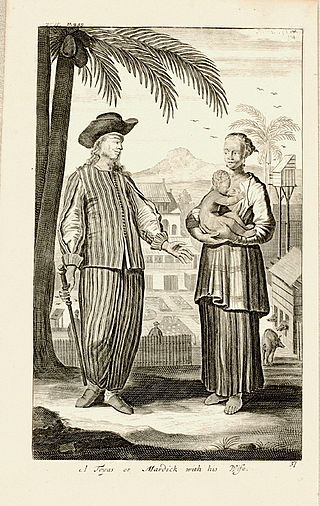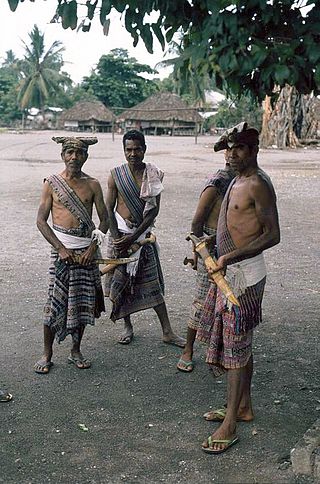
West Timor is an area covering the western part of the island of Timor, except for the district of Oecussi-Ambeno. Administratively, West Timor is part of East Nusa Tenggara Province, Indonesia. The capital as well as its main port is Kupang. During the colonial period, the area was named Dutch Timor and was a centre of Dutch loyalists during the Indonesian National Revolution (1945–1949). From 1949 to 1975 it was named Indonesian Timor.

Portuguese Timor was a colonial possession of Portugal that existed between 1702 and 1975. During most of this period, Portugal shared the island of Timor with the Dutch East Indies.

Tetum is an Austronesian language spoken on the island of Timor. It is one of the official languages of Timor-Leste and it is also spoken in Belu Regency and in Indonesian West Timor.

Great Timor refers to the irredentist concept of a united and independent island of Timor, which is currently divided between the independent state of East Timor and the Indonesian territory of West Timor. The concept of unifying the island has been raised since the mid-20th century.

Pagaruyung, also known as Pagarruyung, Pagar Ruyung and Malayapura or Malayupura, was a kingdom that once stood in the island of Sumatra and the seat of the Minangkabau kings of Western Sumatra. Modern Pagaruyung is a village in Tanjung Emas subdistrict, Tanah Datar regency, located near the town of Batusangkar, Indonesia.

The Bunak people are an ethnic group that live in the mountainous region of central Timor, split between the political boundary between West Timor, Indonesia, particularly in Lamaknen District and East Timor. Their language is one of those on Timor which is not an Austronesian language, but rather a Papuan language, belonging to the Trans–New Guinea linguistic family. They are surrounded by groups which speak Malayo-Polynesian languages, like the Atoni and the Tetum.

The Kemak people are an ethnic group numbering 80,000 in north-central Timor island. They primarily live in the district of Bobonaro, East Timor, while the rest live in the East Nusa Tenggara province of Indonesia.

Amabi was a traditional principality in West Timor in the currently East Nusa Tenggara province of Indonesia. From at least the 17th century to 1917, Amabi played a role in the rivalries between the Portuguese and Dutch colonials on Timor Island.
Sonbai was an Indonesian princely dynasty that reigned over various parts of West Timor from at least the 17th century until the 1950s. It was known as the most prestigious princedom of the Atoni people of West Timor, and is the subject of many myths and stories.

Timor is an island in South East Asia. Geologically considered a continental crustal fragment, it lies alongside the Sunda shelf, and is the largest in a cluster of islands between Java and New Guinea. European colonialism has shaped Timorese history since 1515, a period when it was divided between the Dutch in the west of the island and the Portuguese in the east.

Topasses were a group of people led by the two powerful families – Da Costa and Hornay – that resided in Oecussi and Flores. The Da Costa families were descendants of Portuguese Jewish merchants and Hornay were Dutch.
Liurai is a ruler's title on Timor. The word is Tetun and literally means "surpassing the earth". It was originally associated with Wehali, a ritually central kingdom situated at the south coast of central Timor. The sacral lord of Wehali, the Maromak Oan enjoyed a ritually passive role, and he kept the liurai as the executive ruler of the land. In the same way, the rulers of two other important princedoms, Sonbai in West Timor and Likusaen (Liquica) in East Timor, were often referred as liurais, which indicated a symbolic tripartition of the island. In later history, especially in the nineteenth and twentieth centuries, the term liurai underwent a process of inflation. By this time it denoted any ruler in the Portuguese part of Timor, great or small. In the Dutch part in West Timor the title appears to have been restricted to the Sonbai and Wehali rulers. The rulers in the west were known by the Malay term raja, while there were internally used terms such as usif (lord) among the Dawan-speaking groups, and loro (sun) among the Tetun speakers.

Amanatun was an Atoni princedom situated in what is today Indonesian West Timor, which existed up to 1962. It was also known as the princedom of Onam. The area once included one of the best ports where the commercially important sandalwood was loaded on Dutch and Portuguese ships.
Sonbai Besar or Greater Sonbai was an extensive princedom of West Timor, in present-day Indonesia, which existed from 1658 to 1906 and played an important role in the history of Timor.
Sonbai Kecil or Lesser Sonbai was an Atoni princedom in West Timor, now included in Indonesia. It existed from 1658 to 1917, when it merged into a colonial creation, the zelfbesturend landschap Kupang.

The Sultanate of Tidore was a sultanate in Southeast Asia, centered on Tidore in the Maluku Islands. It was also known as Duko, its ruler carrying the title Kië ma-kolano. Tidore was a rival of the Sultanate of Ternate for control of the spice trade and had an important historical role as binding the archipelagic civilizations of Indonesia to the Papuan world. According to extant historical records, in particular the genealogies of the kings of Ternate and Tidore, the inaugural Tidorese king was Sahjati or Muhammad Naqil whose enthronement is dated 1081 in local tradition. However, the accuracy of the tradition that Tidore emerged as a polity as early as the 11th century is considered debatable. Islam was only made the official state religion in the late 15th century through the ninth King of Tidore, Sultan Jamaluddin. He was influenced by the preachings of Syekh Mansur, originally from Arabia. In the 16th and 17th centuries, the Sultans tended to ally with either Spain or Portugal to maintain their political role but were finally drawn into the Dutch sphere of power in 1663. Despite a period of anti-colonial rebellion in 1780–1810, the Dutch grip on the sultanate increased until decolonization in the 1940s. Meanwhile, Tidore's suzerainty over Raja Ampat and western Papua was acknowledged by the colonial state. In modern times, the sultanate has been revived as a cultural institution.
Amarasi was a traditional princedom in West Timor, in present-day Indonesia. It had an important role in the political history of Timor during the 17th and 18th century, being a client state of the Portuguese colonialists, and later subjected to the Netherlands East Indies.
The Battle of Penfui took place on 9 November 1749 in the hillside of Penfui, near modern Kupang. A large Topass army was defeated by a numerically inferior Dutch East India Company force following the withdrawal of the former's Timorese allies from the battlefield, resulting in the death of the Topass leader Gaspar da Costa. Following the battle, both Topass and Portuguese influence on Timor declined, eventually leading to the formation of a boundary between Dutch and Portuguese Timor which precipitated into the modern border between West Timor and East Timor.

Fort Santo António de Lifau was a Portuguese fort once built by the mouth of the Tono River, in Lifau, district of Oecusse, in East-Timor, the first fort built by the Portuguese Crown, where only forts maintained by Dominican missionaries and Portuguese merchants previously existed.

The Tetum, also known as Tetun or Belu in Indonesia, are an ethnic group that are the indigenous inhabitants of the island of Timor. This ethnic group inhabits the Belu Regency in Indonesia and most of East Timor. Their language is called Tetum, which is part of the Austronesian language family. Apart from the island of Timor, this ethnic group is also found in Jakarta, Indonesia.












